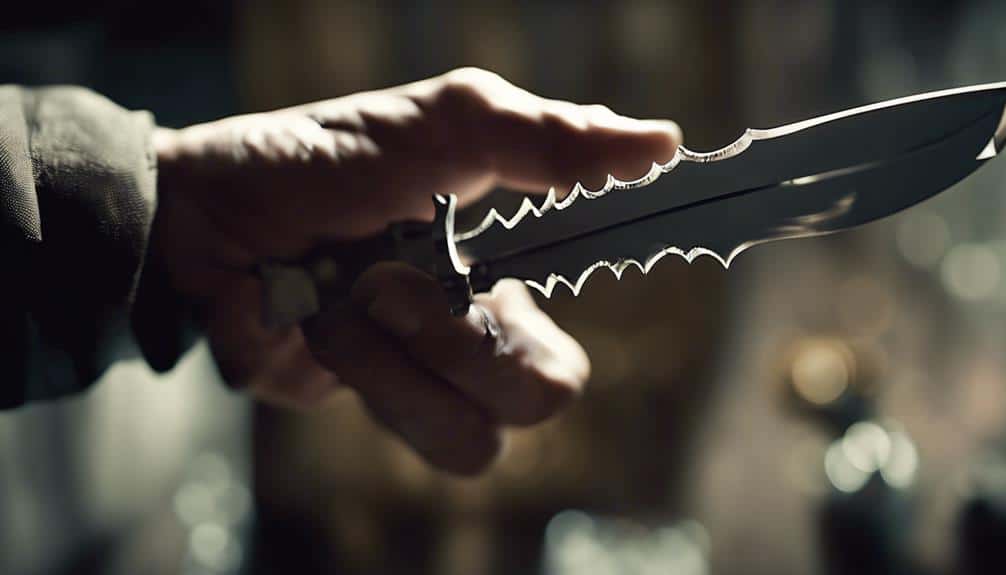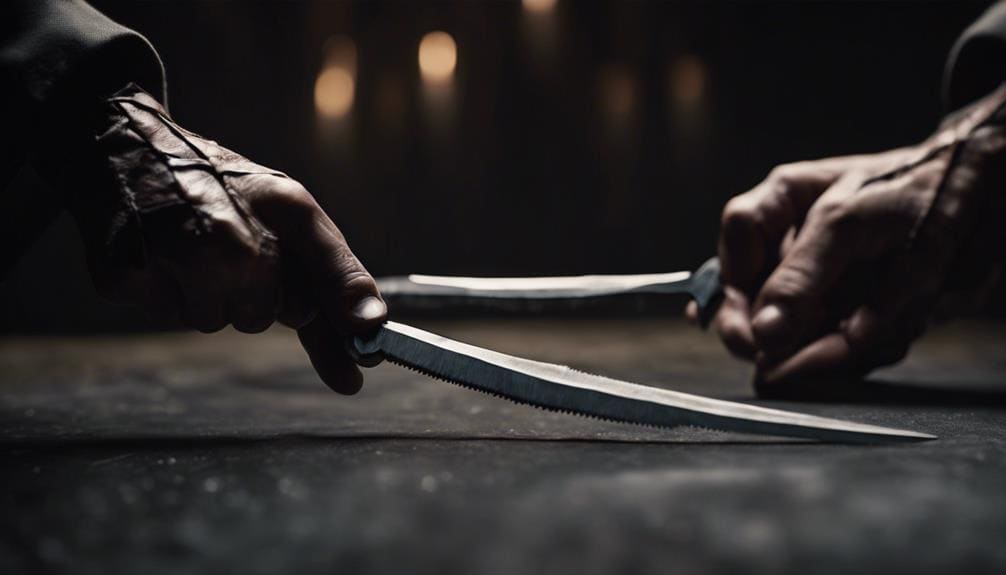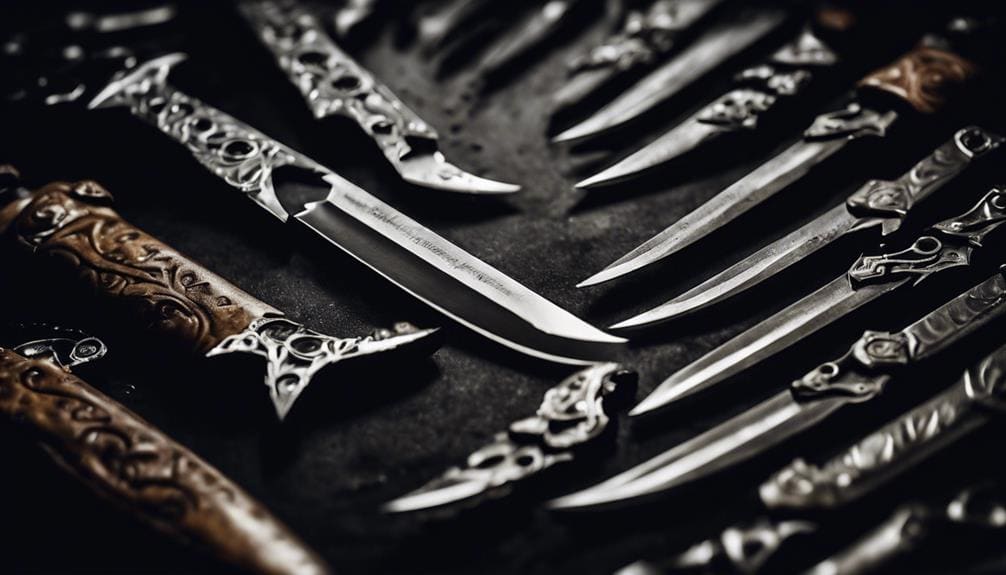You’re about to immerse yourself in the exhilarating world of
butterfly trench knife flipping, where every flick of your wrist sends the blade twirling in a mesmerizing dance. First, nail those
basic open-and-close moves, building muscle memory with each smooth motion. Keep your grip loose, and practice in a clear spot to avoid any oops moments. Feel the knife’s weight, enjoy the fluid flips, and don’t forget the
essential safety tips, like taping the blade or starting with a trainer knife. It takes patience and consistency, but oh, the thrill of
mastering that perfect flip! Ready to reveal more tricks and tips?
Basics of Knife Flipping
Mastering the
basic open and close techniques of a
butterfly knife is essential for developing
smooth and controlled flipping motions. Think of it like learning to ride a bike; once you get the basics down, you’re set for more advanced tricks. When you practice back and forth movements, you’re building those foundational skills. It’s all about
muscle memory and getting comfortable with the knife’s weight and balance. The butterfly knife’s chrome finish not only adds to its aesthetics but also provides a smoother grip which can be helpful during practice.
Now, don’t grip the knife too tightly. You want a
loose grip to let the knife spin naturally in your hand. A tight grip will just mess up your flow and make it harder to pull off those cool tricks you’ve seen. Trust me, it’s all about letting the knife move smoothly, without resistance.
And let’s talk about your wrist.
Proper wrist movement is key. Focus on your
wrist coordination from the get-go, and you’ll see a big difference in how fluid your tricks look. It’s like going back to basics but with a twist—literally!
Ensuring Safety First
Ensuring safety first is essential when practicing with butterfly trench knives. You don’t want to turn your hobby into a visit to the ER, right? Let’s talk safety precautions to keep you flipping without flipping out over an injury.
First, always identify the safe handle of the knife, and keep your fingers away from the sharp blade. Trust me, your fingers will thank you. For beginners, a great tip is to tape the sharp edge of the knife. It’s a simple trick that makes a huge difference in injury prevention. Additionally, make sure to familiarize yourself with the
metal knuckle guard feature, as it can provide an extra layer of safety during practice.
Another fantastic option is to start with trainer knives. These are designed without sharp edges, so you can practice all the cool flips and tricks without the risk of cutting yourself. It’s like having training wheels on a bike – smart and safe.
Practicing in a clear and safe environment is also vital. Make sure your practice area is free from distractions and clutter. This helps you focus and reduces the chances of accidents. Here’s a quick checklist to keep in mind:
- Tape the blade edge for beginners.
- Use trainer knives before moving to live blades.
- Practice in a clear, distraction-free area.
Mastering Grip and Control
When it comes to mastering grip and control with your butterfly trench knife, keeping a
loose grip is key to smooth and fluid flips, letting the knife spin freely without your hand holding it back. The smooth surface of the handle guarantees that your fingers glide effortlessly, enhancing your flipping experience. You’ll also appreciate the
well-balanced design for flipping, which aids in finding that sweet spot between
grip tightness and wrist movement, giving you the flexibility to perform tricks effortlessly. Experimenting with different grip positions on the
safe handle will help you discover the most comfortable and effective hold, making your
practice sessions not just productive but also a lot of fun.
Loose Grip Techniques
Achieving fluidity in butterfly knife flips hinges on mastering a loose grip, which allows the knife to move naturally without being hindered by tension. You want to feel the knife glide through your fingers, almost like it’s an extension of your hand. This is where grip relaxation techniques come into play.
By focusing on letting your fingers stay relaxed, you can maintain control without gripping too tight. Remember, a death grip leads to jerky motions, while too loose a grip might send your knife flying! To find that sweet spot, experiment with different grip positions on the safe handle. Discovering your personal comfort zone is one of the
best knife handling tips you can follow.
Regular practice is key for developing muscle memory, making fluid motion exercises a daily habit. This will help you achieve those smooth flips that look effortless.
- Experiment with grip positions: Try holding the knife at different points to see what feels best.
- Practice relaxation techniques: Focus on keeping your hand loose and flexible.
- Daily repetition: Consistent practice helps build muscle memory.
Don’t rush it; mastery takes time. With patience and practice, you’ll be flipping like a pro in no time!
Optimal Wrist Movement
Mastering a
loose grip is just the start; now it’s time to explore
perfect wrist movement to elevate your butterfly knife skills. You’ve got the grip down, but without proper
wrist coordination, those tricks won’t look nearly as impressive. Let’s plunge into some wrist coordination tips to get you flipping like a pro.
First, maintaining a loose grip makes your wrist more flexible, allowing for smoother spins. Incorrect wrist movements can lead to failed flips or, worse, finger injuries. So, start with
fluid motion exercises—practice flicking your wrist gently back and forth. This helps build the muscle memory you need for those advanced maneuvers.
Next,
grip adjustment strategies are key. Experiment with different positions on the safe handle to find what feels most comfortable. This tailor-fit approach guarantees you have
peak control during flips.
Then, focus on
wrist flick techniques. Think of your wrist as a whip—quick, sharp motions are your best friend here. With patience and persistence, these small adjustments will make a big difference.
Effective Practice Routine
Alright, let’s kick off your practice routine by mastering the
basic open and close techniques of the
butterfly knife—this is your foundation, so don’t skip it! Break down each trick into bite-sized steps to make sure you’re getting it right and keep at it daily to build that
muscle memory. Start adding wrist flicks early on to get that essential control, and only move on to fancier moves when you’re comfortable with the basics—smooth and steady wins the race!
Basic Techniques Breakdown
When you’re starting with butterfly trench knives, it’s vital to focus on the essentials. Immerse yourself in the butterfly knife history for a better understanding of its evolution and significance. Your first step should be to master the basic opening and closing techniques. These foundational moves are the bedrock of all other skills you’ll learn.
To set yourself up for success, verify you have the necessary tools. A good practice knife is your best friend here—one that’s safe and durable. Start with the basics:
- Hand-Eye Coordination: Practice back and forth movements to develop this important skill.
- Grip Mastery: Keep a loose grip to maintain control and fluidity during spins and tricks.
- Wrist Flick Techniques: Regularly refine these to guarantee smooth execution of advanced maneuvers.
Use beginner resources like online tutorials and instructional videos to guide you. They break down complex techniques into manageable steps, making learning less intimidating. Remember, patience is key. Gradually introduce more complex movements only after you’ve nailed the basics. Building a solid foundation now will make your journey smoother and more enjoyable. So, grab those butterfly trench knives and get flipping!
Consistent Daily Practice
To truly excel with butterfly trench knives, developing a consistent daily practice routine is essential. Start with 10-15 minutes of basic open and close techniques to lay the foundation. These initial moves may seem simple, but they’re significant for building muscle memory and control. Mix in back and forth flips and spins to keep things interesting and ramp up your skills.
Focus on wrist movement and grip adjustments to refine your efficiency. Remember, it’s not just about looking cool—these details prevent finger injuries as you progress. Consistency is key, so aim for regular sessions throughout the week. Only introduce complex techniques after mastering the basics.
Set clear goals, track your progress, and find motivation to stay on track. A trainer knife is your best friend here, reducing the risk of cuts and letting you concentrate on perfecting your moves without fear.
Here’s a quick table to keep you on track:
| Practice Element |
Time Spent |
Purpose |
| Basic Techniques |
10-15 minutes |
Build foundational skills |
| Varied Movements |
10 minutes |
Enhance muscle memory |
| Wrist & Grip Adjustments |
Ongoing |
Refine efficiency, prevent injury |
Keep pushing, and you’ll be flipping like a pro in no time!
Troubleshooting Common Issues
Mastering
butterfly trench knives involves overcoming several common issues that can hinder your progress. You might find yourself struggling with flipping techniques, making common mistakes, or figuring out effective practice strategies. Don’t worry, though—everyone goes through this phase! Here’s a breakdown to help you troubleshoot these challenges:
- Break Down Each Trick: Start by dividing each flip into smaller, manageable steps. This makes it easier to focus on one part at a time and reduces frustration.
- Stick to Basics: If you’re having trouble, go back to basic wrist flick techniques. These foundational moves are essential for control and coordination.
- Consistency is Key: Practice regularly to build muscle memory. Just a few minutes each day can make a huge difference over time.
When you’re practicing, it’s easy to overthink or get your wrist movements all wrong. Stay patient and persistent. Remember, everyone makes mistakes, and that’s part of learning. Watch experienced flippers for insights but focus on hands-on practice more. With a good practice routine, you’ll soon see those tricky maneuvers becoming second nature. So, keep flipping, stay focused, and have fun—you’ve got this!
Tackling Advanced Techniques
Diving into the domain of
advanced techniques with butterfly trench knives demands exceptional
wrist control and
dexterity. To master advanced
flipping strategies, start with wrist control drills. Imagine your wrist as the pivot—fluid and responsive. Work on
flicking the knife with
precision, avoiding finger nicks. The
removable knuckle guard can be a useful feature during practice to prevent injuries.
Timing coordination exercises are your next step; they guarantee you spin the knife without hitting your fingers. It’s like a dance—each move needs perfect timing.
Experimenting with different
grip positions on the safe handle can make a world of difference. Find your comfort zone, where the knife feels like an extension of your hand. This comfort is essential for executing advanced moves smoothly, without thinking too much and losing that fluidity.
Remember, shifting to these advanced techniques isn’t a sprint. You’ve got to walk before you can fly. Make certain your
basic flicks and movements are second nature. This way, you won’t overthink and mess up your flow.
Look at experienced flippers for inspiration, but don’t forget—consistent, hands-on practice is the key. You’ll get those complex movements down in no time. Keep flipping, keep practicing, and most importantly, keep your fingers safe!
Overcoming Common Challenges
Why do so many beginners hit a wall when flipping butterfly trench knives? It’s all about mastering rhythm and fine-tuning your technique. You’re not alone in facing these challenges, and with some mental focus techniques, you can overcome them. Additionally, using premium quality steel construction in your knife can greatly improve your flipping experience. The durability and balance of a well-crafted knife make a notable difference.
First, break down each motion into smaller, manageable steps. This helps improve coordination and builds your confidence. Flipping involves simultaneous movements, so isolating each part allows you to focus on mastering one thing at a time.
- Practice wrist flick techniques: Your wrist action is essential for smooth flips. Concentrate on flicking your wrist during practice sessions to enhance control and fluidity.
- Stay relaxed: Overthinking can trip you up. Instead, maintain a relaxed mindset. Rely on muscle memory and let your hands do the work.
- Experiment with grip positions: Find your comfort zone by trying different grips on the safe handle. The right grip can make all the difference.
Don’t forget, regularly returning to basic techniques and maintaining consistent practice routines is key. Use anxiety management strategies to stay calm and focused. With patience and persistence, you’ll turn those challenges into triumphs. Happy flipping!
Frequently Asked Questions
Is Butterfly Knife Flipping a Hobby?
Yes, butterfly knife flipping is a hobby. You’ll immerse yourself in butterfly knife history, master flipping techniques, and always follow safety precautions. It’s a blend of skill and creativity, building a community and sometimes leading to competitive opportunities.
What Balisong Tricks Should I Learn First?
“Practice makes perfect!” Start with beginner techniques like the basic flip and fan. Prioritize safety practices by using trainer knives and maintaining your knife properly. These steps guarantee you build solid skills while avoiding injuries and keeping your knife in top shape.
Can You Do Tricks with a Butterfly Knife?
Yes, you can definitely do tricks with a butterfly knife. Focus on mastering basic butterfly knife techniques first. Always prioritize safety precautions by using a trainer knife. Consistent practice and patience are key performance tips for improving your skills.
In What States Are Butterfly Knives Legal?
Imagine you’re in Texas, flipping a butterfly knife without worry. Butterfly knife laws vary; some states like Texas have no legal restrictions, while others have strict state regulations. Always check local laws to stay compliant.







